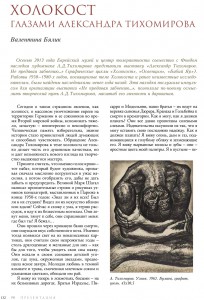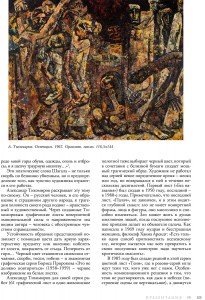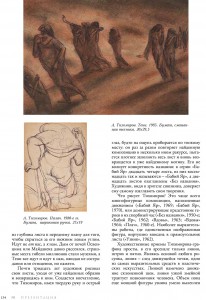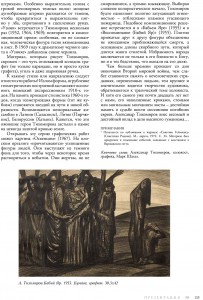Valentina Byalik
Member of the International Art-historian Association
«Russian art» magazine, # 4, 2013
Nowadays, it’s not easy to bring back to memory such a terrible event as Holocaust; for some it is of no interest, for others it is uneasy and discomforting topic. Human’s memory is selective. The average level of education in the country is decreasing, that is why knowledge of history becomes a privilege of a few, if not chosen ones, but at least thinking people, people capable of feeling. The fact that Alexander Tikhomirov turned to the theme of Holocaust does credit to his spiritual qualities, moreover, it opens something new in the views of this extraordinary master on art.
The word “holocaust” derives from the English language, where, in its roots, lies ancient greek “ὁλοκαύστος” – “all-burning”. In the narrow sense, this word means pursuance and mass extermination of Jews, living in Germany, on the territory of its allies and on the territories it had occupied during the Second World War. Furthermore, this term also applies to systematic pursuance and extermination of European Jews by NAZI Germany and its collaborators between the years 1933-1945. As with genocide of Georgians in the Osman Empire, the Holocaust is considered to be one of the most well-known examples of genocide in the twentieth century. In the broad sense – it is pursuance and mass extermination by NAZIS of representatives of different ethnic and social groups (Jews, gypsies, masons, helplessly ill and others) at a time of the Third Reich.
It is believed that the voice of blood is that very warning bell which wakes up the artist, asking him to first mentally sink into the horrors of violence and then portray it, therefore not letting us forget as well as warning us. Having seen the drawings of convicts in concentration camps, exhibited in Poland in the 1960s, the great Mark Chagall wrote strident lines: “Had I known them all? Was I in their studios? Have I seen their artwork, up close or from afar? Right now I am losing my mind, I am losing reason, I head to their obscure graves. They call for me, draw me towards them, they ask me: where had I been? I had been running…”
They had gone through the bloodbath of death; they had felt the taste of their own sweat. That was when their not yet drawn paintings lightened up, they have been going through their yet not lived years – so precious and wanted – in order to see their own dreams in reality. They searched their subconscious trying to find a corner of their childhoods, where the moon, surrounded by stars, promised them bright tomorrow. Young love in a dark room, and grass, dewed with milky juice and strewed with flowers, held a promise of heaven.
I see them now in rags, barefoot, on their silent journeys. The Izrael Brothers, Pisarro and Modigliani, our brothers, are lead on a leash to their deaths in crematorium, by the sons of Dürer, Krana and Holbein. How can I, how should I cry? It is long since they are saturated with salty tears. Torture has drenched them to the point where I can leave my last hope. How must I cry? I see fire, smoke and gas, lifting towards the blue sky and conceal it. I see ripped out hair and teeth. They are the furious colours of my palette. I am in a desert – ahead of me are mountains of shoes, clothes, fire and waste, and I whisper a mournful prayer.
Towards me comes David, right off my paintings, portrayed with a lira in his hand. He wants to help me in my sorrow, and so he sings from the books of Psalms. Our Moses follows him. Do not be afraid, and he asks you to lie still until he has inscribed a New Testament for a New World. “The last word fades, the last body disappears… Silence, as if a new Great Flood is coming, I rise and send you my last farewell greeting, I am on my way to the Temple and there I light a candle in front of your painting”.
These poetic words of Chagall are not simply the woe for innocent victims, but also predetermination of the way in which he would portray this theme in his works. In addition to the themes of violence, which can be seen on his canvases (as at a young age he had been the witness to annihilation in his own native country), the theme of sorrow and lamentation is much more developed in his work.
Alexander Tikhomirov, who left behind no records, memoirs or notes on his life, opens this theme in his own individual way. He is a Russian man, and his referral to the theme of the Holocaust is, in its own way, an act of bravery, both moral and artistic. Thus, we are able to speak of him as of a man with the delicacy of his sense for right and wrong, and of his works as of graphic paintings of extraordinary strength and intensity.
An object or event always acquires, with the help of colour, its most bright characteristic, allowed by the stability of abstract interpretations. A man becomes pale from anger, reddens from embarrassment, turns blue from the cold, and becomes black from grief. Black becomes a symbol of despair, sorrow, anguish and ruin. There is nothing surprising in the fact that once famous graphic series by Boris Prorokov, “This must not be repeated” (1958-1959), is a black image on white canvases. Alexander Tikhomirov also chooses black colour, which, in combination with the white paper, creates a distinct and tragic image.
This series consists of 61 graphic works and one artistic canvas. Analysis of the dates of their creation allows us to come to an interesting conclusion. The artist did not work on this series for a certain period of time – a month or a year, but returned to it throughout decades. The first painting (“Untitled”) was created in the year 1950, the last – in the 1980s. Remarkably, the last work, “Executioner”, is not completed, and there’s certain hidden meaning in it. Evil does not have a strict form, face or shape. It is multifaceted, is capable of change and mimicry, taking on a variety of faces. But what is especially crucial, is that it can live in the souls of millions of people in times when it’s not an ability to critically perceive reality but obedient execution of orders which turns ordinary people on the streets into slaughterers. In 1969, wise and fearless woman philosopher by the name of Hannah Arendt wrote: “There is only one way to oppose universal evil, which tries to convert us all into its obedient monsters: we must learn to think critically”.
A rare – for this series – colour piece, “Shadows”, where the shadows of those that no longer live walk in the pink-grey twilight, was created in 1985. What makes its composition unique is that these shadows do not dissolve like smoke in the sky (i.e. the scene’s construction is not vertical); instead, they walk from the depths of painting towards foreground in order to vanish behind its lower left corner. They walk not away from us, but towards us. The smoke of the gasrooms of Auschwitz or Maidenak have dissipated long time ago, horrific places of death to millions have become museums, yet the Shadows continue to walk and walk towards us, expecting neither sympathy nor avengement, but remembrance.
For almost thirty years the artist worked on his paintings, abandoning once discovered forms and then returning to them again. It appears that, having a steady hand and a sharp eye, Tikhomirov, as if solely by feel and touch, finds his was way through the swamps: he repeats this newfound composition again and again from a slightly different angle, trying to fill the canvas as much as possible, and then once again returns to the original, already found, motif. Specificity of the titles is not of his concern either: in the series “Babi Yar” we can find 24 paintings, of which 18 share the exact same title – “Baby Yar”. Moreover, 12 works are headed “Unnamed”. This, not in the least bit, shows that the artist neglects a need in giving his creations names. Seeing the observer in the audience as an ally, he trusts him to title this creations himself.
What does he paint? More often it is the multi-figure compositions, which are either filled with dynamic movement (“Babi Yar”, 1969; “Babi Yar”, 1970) or demonstrate the characters’ anticipation in their hour of mourning (“Unnamed”, 1950s; “Babi Yar”, 1962; “Widows”, 1963; “Widows”, 1964; “Cry”, 1960s). Among the most expressive works we could rightly name those with only one figure skilfully drawn into the rectangular canvas (“Prisoner”, 1962). It seems that it is that same Michelangelo sculpture, which, having fallen down the slope, has not lost its protruding parts.
Observing this piece, one notices simplicity of artistic techniques used by the artist. The artist-graphic has only three of these techniques at his disposal: line, stroke and spot. A trace of a moving point, a line, happening to make foundation to any painting, is one of the most expressive in plastic arts. In this case, the line is used to sketch out movement of the bent neck; it manipulates the whole spine of a human with its fine line. The artist follows this with a hatch/stroke. As with the line, it serves as one of the main foundations to the painting and is achieved by the sole movement of the hand. When working in a hatching manner, the artist sharpens the pencil, charcoal, and sanguine using the “spatula” or draws with side surface of the lead as opposed to the sharp tip.
The mass of the whole – still mighty – figure of the prisoner is portrayed by hatches. The head with tangled shag of dark disobedient hair is particularly expressive. The hair parts from the crown of head in powerful bowlike strokes in order to then become a bold mark beside the forehead hidden in clutched hands. We often encounter “Prisoner” in Tikhomirov’s works (1952, 1964, 1969), where the same compositional technique is repeated: a tightly page-fitting, crouching, but not broken, human figure. In the 1969 piece, blue ink is added to existing dramatic black.
Material, which Tikhomirov uses to paint, is humble and does not claim to be unique. It is graphite, charcoal and even ball pen. One wanders whether, back in 1790 in France, Nicolas-Jacques Conté, could suppose, as he mixed graphite with clay, that he would come up with a solution, suitable for creation of different pencil hardness, from then on used by everyone who could hold this tool in their hands. It was he, too, who suggested framing graphite rods with little wooden planks; thus it would make them less fragile and much easier to use. The graphite pencil is the most common and widely used of all pencils. However, it is also possible to work with a simple piece of graphite, which is exactly what Tikhomirov did. Graphite has a tendency towards slightly colder play of colours and is capable of projecting a complex world of feelings.
To which style or artistic direction can we attribute these emotional works? They are predominated by expressive beginnings. The deformation of the form, the coarsening of geometrical structures makes one recall German Expressionism of the 1910s. Furthermore, it also reminds us of stylistic graphics and sculptures of the 1960s, when geometrization of forms (being in fact a cubism) became a star on the path to a new abstractness. We recall those memorial ensembles in Latvia (Salaspiels), Lithuania (Pirčiupiai), Belarus (Hatin). It seems that these heroes of Tikhomirov which had come to life are forever frozen in stone on a once bloodstained earth.
“Auschwitz” (1967) is the work, which may open this series of graphic works. Flattened figures of people appear on the level hardboard. They emerge from the faded background just so that, in a while, they can recede, vanishing into nothing. They are victims, however, not passive but instead loudly calling upon. Having chosen a difficult colouristic beginning, Tikhomirov seemingly fills the canvas with a glow of fires, or, perhaps, it is the decaying fiery, like the reflection of flames of the extinguished fire. “Babi Yar” (1955) and “Remembrance (Babi Yar)” (1955) also showcase such compositional decisions. Tightly pressed bodies are tied together not only by anticipation of impending death, but by realization of the length of the grievous path, which lasts over many centuries. The Chosen Ones are not solely attributed so due to their proximity to God, but also because of those calamities, which befall on them.
The more decades pass since the day the Second World War came to an end, the shorter becomes the memory of inhumane sufferings, experienced by people, and the larger and more significant becomes the name of the Artist, which addresses this tragic theme of the Holocaust. And although for 20 years he himself is no longer with us, his paintings, filled with cries, moans and graveyard silences, are a worthy memory of the fate of six million killed Jews. Alexander Tikhomirov brought a weighty and valuable contribution to the cause of great humanism…



